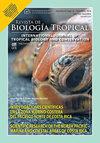Assessment of Vibrio populations in a transect of Rhizophora mangle in Punta Galeta, Panamá: culture-dependent analyses reveal biotechnological applications
IF 0.6
4区 生物学
Q4 BIOLOGY
引用次数: 0
Abstract
Introduction: Rhizophora mangle is considered a niche for microorganisms with potentially novel and complex degrading enzymes. Objective: To characterize Vibrio populations using culture-dependent methods, from samples collected from sediments and water along a red mangrove transect composed of three sites. Methods: Strains were characterized according to their distribution, diversity, degradation of organic matter, and environmental parameters. Results: Bacterial densities were strongly associated with temperature and salinity. A total of 87 good-quality sequences representing the isolates from the three sites, were binned into eight OTUs (Operational taxonomic units). Taxonomic assignment indicated that the dominant members were Vibrionaceae. Beta diversity analyses showed that bacterial communities clustered by sample source rather than spatial distribution, and that alpha diversity was found to be higher in water than in sediment. Three percent of the strains from water samples could degrade carboxyl-methyl cellulose with the smallest enzymatic indexes compared to 4 % of the strains from sediment samples that showed the highest enzymatic indexes. Two strains identified as Vibrio agarivorans degraded cellulose and agarose, producing the highest enzymatic indexes. Conclusions: We found higher bacterial densities and diversity in the bacterial communities of the water samples compared to the sediment, with different OTUs including those similar to Ferrimonas, Providencia, or Shewanella which were not isolated in the sediment. Vibrio OTUs were shown to degrade cellulose in both sample types. The results of this study highlight the importance of red mangroves as Vibrio habitats and as reservoirs of potential enzyme sources with biotechnological applications.巴拿马蓬塔加莱塔根霉manggle样带弧菌种群评估:依赖培养的分析揭示了生物技术的应用
根霉被认为是微生物的一个生态位,具有潜在的新型和复杂的降解酶。目的:利用依赖培养的方法,从由三个地点组成的红树样带的沉积物和水中收集样品,以表征弧菌种群。方法:根据菌株的分布、多样性、有机物降解和环境参数对菌株进行表征。结果:细菌密度与温度和盐度密切相关。共有87个高质量的分离菌株序列被划分为8个otu (Operational taxonomic units)。分类学鉴定结果表明,其优势成员为弧菌科。β多样性分析表明,细菌群落的聚类主要依据样品来源而非空间分布,水体中的α多样性高于沉积物。水样品中3%的菌株能以最小的酶指标降解羧甲基纤维素,而沉积物样品中4%的菌株能以最高的酶指标降解羧甲基纤维素。鉴定为agarivorans的两株菌株降解纤维素和琼脂糖,产生最高的酶指标。结论:与沉积物相比,水样中细菌群落的密度和多样性更高,其OTUs不同,包括与沉积物中未分离的Ferrimonas, Providencia或Shewanella相似的细菌。OTUs弧菌在两种样品类型中均能降解纤维素。本研究结果强调了红红树林作为弧菌栖息地和潜在酶源库的重要性,具有生物技术应用价值。
本文章由计算机程序翻译,如有差异,请以英文原文为准。
求助全文
约1分钟内获得全文
求助全文
来源期刊

Revista De Biologia Tropical
生物-生物学
CiteScore
1.80
自引率
0.00%
发文量
23
审稿时长
4-8 weeks
期刊介绍:
The Revista de Biología Tropical / International Journal of Tropical Biology and Conservation is a mainstream scientific journal published since 1953 and covered by Web of Science; Science Citation Index; Current Contents; Google Scholar; Scopus, SciELO and nearly 50 additional indices.
A double blind system guarantees you a fair evaluation, and our world class editorial and scientific boards provides a first decision in three working days. The journal is Full Open Access and is widely read where your article can have the highest real impact.
Since its beginning in 1953, the Revista follows these principles: objective and independent evaluation of all manuscripts; transparency in all processes; ethical use of procedures, data, specimens and subjects; fair treatment of all parties; and absolute predominance of scientific rigor over any other aspect.
 求助内容:
求助内容: 应助结果提醒方式:
应助结果提醒方式:


